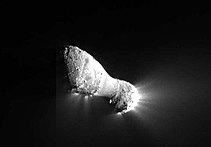
On March 11, 1998, asteroid astronomers around the world received an ominous message: new observational data on the recently discovered asteroid 1997 XF11 suggested there was a chance that the half-mile-wide object could hit Earth in 2028.
The message came from the Minor Planet Center, in Cambridge, Massachusetts, the worldwide repository for such observations and initial determination of asteroid orbits. And although it was intended to alert only the very small astronomical community that hunts and tracks asteroids to call for more observations, the news spread quickly.
Most media outlets did not know what to make of the announcement, and mistakenly highlighted the prospect that Earth was doomed.
Fortunately, it turned out that Earth was never in danger from 1997 XF11. After performing a more thorough orbit analysis with the available asteroid observations, Don Yeomans, then the leader of the Solar System Dynamics group at JPL, along with his colleague Paul Chodas, concluded otherwise. “The 2028 impact was essentially impossible,” said Chodas, who is now director of NASA’s Center for Near-Earth Object Studies (CNEOS), located at JPL.
“To this day we still get queries on the chances of XF11 impacting in 2028,” Chodas said. “There is simply no chance of XF11 impacting our planet that year, or for the next 200 years.”
Chodas knows this thanks to CNEOS’ precise orbit calculations using observation data submitted to the Minor Planet Center by observatories all over the world that detect and track the motion of asteroids and comets. For the past two decades, CNEOS calculations have enabled NASA to become the world leader in these efforts, keeping close watch on all nearby asteroids and comets—especially those that can cross Earth’s orbit.
“We compute high-precision orbits for all asteroids and comets and map their positions in the solar system, both forward in time to detect potential impacts, and backward to see where they’ve been in the sky,” Chodas said. “We provide the best map of orbits for all known small bodies in the solar system.”
Near-Earth objects (NEOs) are asteroids and comets in orbits that bring them into the inner solar system, within 121 million miles of the Sun, and also within roughly 30 million miles of Earth’s orbit around the Sun.
NASA’s original intent was to fulfill a 1998 Congressional request to detect and catalogue at least 90 percent of all NEOs larger than one kilometer in size (roughly two-thirds of a mile) within 10 years.
A CNEOS system called “Sentry” searches ahead for all potential future Earth impact possibilities over the next hundred years—for every known NEO. Sentry’s impact monitoring runs continually using the latest CNEOS-generated orbit models, and the results are stored online. In most cases so far, the probabilities of any potential impacts are extremely small, and in other cases, the objects themselves are so small—less than 66 feet across— that they would almost certainly disintegrate even if they did enter Earth’s atmosphere.
More recently, CNEOS also developed a system called Scout to provide more immediate and automatic trajectory analyses for the most recently discovered objects, even before independent observatories confirm their discovery. Operating around the clock, the Scout system identifies the highest priority objects to be watched.


Be the first to comment